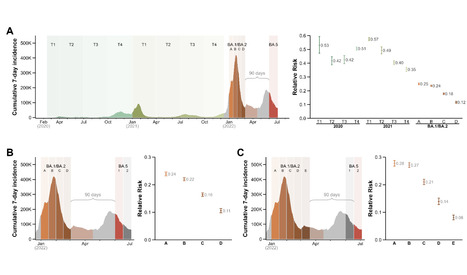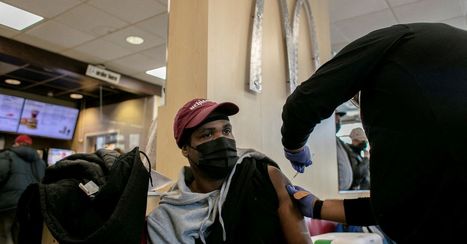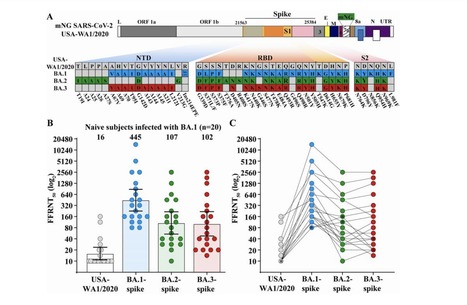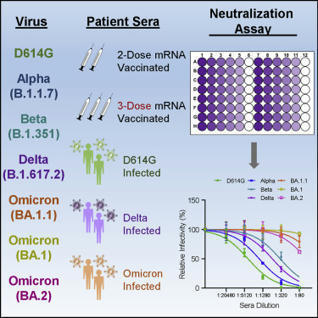 Your new post is loading...

|
Scooped by
Juan Lama
|
SARS-CoV-2 omicron subvariants BA.1 and BA.2 became dominant in many countries in early 2022. These subvariants are now being displaced by BA.4 and BA.5. While natural infection with BA.1/BA.2 provides some protection against BA.4/BA.5 infection, the duration of this protection remains unknown. We used the national Portuguese COVID-19 registry to investigate the waning of protective immunity conferred by prior BA.1/BA.2 infection towards BA.5. We divided the individuals infected during the period of BA.1/BA.2 dominance (>90% of sample isolates) in successive 15-day intervals and determined the risk of subsequent infection with BA.5 over a fixed period. Compared with uninfected people, one previous infection conferred substantial protection against BA.5 re-infection at 3 months (RR=0.12; 95% CI: 0.11-0.12). However, although still significant, the protection was reduced by two-fold at 5 months post-infection (RR=0.24; 0.23-0.24). These results should be interpreted in the context of vaccine breakthrough infections, as the vaccination coverage in the individuals included in the analyses is >98% since the end of 2021. This waning of protection following BA.1/BA.2 infection highlights the need to assess the stability and durability of immune protection induced with the adapted vaccines (based on BA.1) over time. Preprint available at medRxiv (August 17, 2022): https://doi.org/10.1101/2022.08.16.22278820

|
Scooped by
Juan Lama
|
Infection with SARS-CoV-2 virus is associated with a wide range of symptoms. The REal-time Assessment of Community Transmission -1 (REACT-1) study has been monitoring the spread and clinical manifestation of SARS-CoV-2 among random samples of the population in England from 1 May 2020 to 31 March 2022. We show changing symptom profiles associated with the different variants over that period, with lower reporting of loss of sense of smell and taste for Omicron compared to previous variants, and higher reporting of cold-like and influenza-like symptoms, controlling for vaccination status. Contrary to the perception that recent variants have become successively milder, Omicron BA.2 was associated with reporting more symptoms, with greater disruption to daily activities, than BA.1. With restrictions lifted and routine testing limited in many countries, monitoring the changing symptom profiles associated with SARS-CoV-2 infection and induced changes in daily activities will become increasingly important. Preprint in medRxiv (May 23, 2022): https://doi.org/10.1101/2022.05.21.22275368

|
Scooped by
Juan Lama
|
Two new sublineages of the Omicron coronavirus variant can dodge antibodies from earlier infection well enough to trigger a new wave, but are far less able to thrive in the blood of people vaccinated against COVID-19, South African scientists have found. The scientists from multiple institutions were examining Omicron's BA.4 and BA.5 sublineages - which the World Health Organization last month added to its monitoring list. They took blood samples from 39 participants previously infected by Omicron when it first showed up at the end of last year. Fifteen were vaccinated - eight with Pfizer's shot; seven with J&J's -- while the other 24 were not. "The vaccinated group showed about a 5-fold higher neutralisation capacity ... and should be better protected," said the study, a pre-print of which was released over the weekend. In the unvaccinated samples, there was an almost eightfold decrease in antibody production when exposed to BA.4 and BA.5, compared with the original BA.1 Omicron lineage. Blood from the vaccinated people showed a threefold decrease. South Africa may be entering a fifth COVID wave earlier than expected, officials and scientists said on Friday, blaming a sustained rise in infections that seems to be driven by the BA.4 and BA.5 Omicron sub-variants. Only about 30% of South Africa's population of 60 million is fully vaccinated. "Based on neutralisation escape, BA.4 and BA.5 have potential to result in a new infection wave," the study said. Cited research availanble (April 29, 2022) at https://secureservercdn.net/166.62.108.196/1mx.c5c.myftpupload.com/wp-content/uploads/2022/04/MEDRXIV-2022-274477v1-Sigal.pdf

|
Scooped by
Juan Lama
|
The Omicron SARS-CoV-2 has three distinct sublineages, among which sublineage BA.1 is responsible for the initial Omicron surge and is now being replaced by BA.2 worldwide, whereas BA.3 is currently at a low frequency. The ongoing BA.1-to-BA.2 replacement underscores the importance to understand the cross-neutralization among the three Omicron sublineages. Here we tested the neutralization of BA.1-infected human sera against BA.2, BA.3, and USA/WA1-2020 (a strain isolated in late January 2020). The BA.1-infected sera neutralized BA.1, BA.2, BA.3, and USA/WA1-2020 SARS-CoV-2s with geometric mean titers (GMTs) of 445, 107, 102, and 16, respectively. Thus, the neutralizing GMTs against heterologous BA.2, BA.3, and USA/WA1-2020 were 4.2-, 4.4-, and 28.4-fold lower than the GMT against homologous BA.1, respectively. These findings have implications for vaccine strategy. Preprint available in bioRxiv (March 31, 2022): https://doi.org/10.1101/2022.03.30.486409

|
Scooped by
Juan Lama
|
BACKGROUND: Qatar experienced a large SARS-CoV-2 Omicron (B.1.1.529) wave that started on December 19, 2021 and peaked in mid-January, 2022. We investigated effects of Omicron subvariant (BA.1 and BA.2), previous vaccination, and prior infection on infectiousness of Omicron infections, between December 23, 2021 and February 20, 2022. METHODS: Univariable and multivariable regression analyses were conducted to estimate the association between the RT-qPCR cycle threshold (Ct) value of PCR tests (a proxy for SARS-CoV-2 infectiousness) and each of the Omicron subvariants, mRNA vaccination, prior infection, reason for RT-qPCR testing, calendar week of RT-qPCR testing (to account for phases of the rapidly evolving Omicron wave), and demographic factors. RESULTS: Compared to BA.1, BA.2 was associated with 3.53 fewer cycles (95% CI: 3.46-3.60), signifying higher infectiousness. Ct value decreased with time since second and third vaccinations. Ct values were highest for those who received their boosters in the month preceding the RT-qPCR test - 0.86 cycles (95% CI: 0.72-1.00) higher than for unvaccinated persons. Ct value was 1.30 (95% CI: 1.20-1.39) cycles higher for those with a prior infection compared to those without prior infection, signifying lower infectiousness. Ct value declined gradually with age. Ct value was lowest for those who were tested because of symptoms and was highest for those who were tested for travel-related purposes. Ct value was lowest during the exponential-growth phase of the Omicron wave and was highest after the wave peaked and was declining. CONCLUSIONS: The BA.2 subvariant appears substantially more infectious than the BA.1 subvariant. This may reflect higher viral load and/or longer duration of infection, thereby explaining the rapid expansion of this subvariant in Qatar. Preprint available in medRxiv (March 4, 2022): https://www.medrxiv.org/content/10.1101/2022.03.02.22271771v1.full.pdf

|
Scooped by
Juan Lama
|
The newly found Omicron SARS-CoV-2 variant of concern has rapidly spread worldwide. Omicron carries numerous mutations in key regions and is associated with increased transmissibility and immune escape. The variant has recently been divided into four subvariants with substantial genomic differences, in particular between Omicron BA.1 and BA.2. With the surge of Omicron subvariants BA.1 and BA.2, a large number of reinfections from earlier cases has been observed, raising the question of whether BA.2 specifically can escape the natural immunity acquired shortly after a BA.1 infection. To investigate this, we selected a subset of samples from more than 1,8 million cases of infections in the period from November 22, 2021, until February 11, 2022. Here, individuals with two positive samples, more than 20 and less than 60 days apart, were selected. From a total of 187 reinfection cases, we identified 47 instances of BA.2 reinfections shortly after a BA.1 infection, mostly in young unvaccinated individuals with mild disease not resulting in hospitalization or death. In conclusion, we provide evidence that Omicron BA.2 reinfections do occur shortly after BA.1 infections but are rare. Preprint available in medRxiv (Feb. 22, 2022): https://doi.org/10.1101/2022.02.19.22271112

|
Scooped by
Juan Lama
|
'Only having a transmissibility advantage at this stage of the game isn't a total showstopper'. The Omicron sublineage BA.2 is making headlines for its potentially increased transmissibility as its prevalence rises in some countries, but experts aren't too concerned about the variant just yet. Late last week, the U.K. Health Security Agency designated BA.2 a "variant under investigation" as cases were doubling every 4 days and showing a 120% growth advantage over the original Omicron clade, known as BA.1, said Katelyn Jetelina, PhD, MPH, an epidemiologist at UT Health Science Center at Houston. Other countries, including Denmark, Norway, Sweden, and India, have seen similar growth for BA.2, Jetelina reported in her Substack email. Still, she said, it's "likely nothing like the huge transmissibility jump we saw from Delta to Omicron," which was a 500% growth advantage. So far some 8,000 cases of BA.2 have been detected in 40 countries, according to news reports. BA.2 is not a new sublineage. It was first detected in December and made headlines then as the "stealth" Omicron variant because it did not have the same s-gene target failure on PCR testing that BA.1 did. That's because it lacks the spike deletions 69-70 in BA.1, so s-gene targets still turn up positive. That means BA.2 doesn't have a special signal that tells labs it's Omicron, so labs now must go to genetic sequencing to identify variants, Jetelina said. She added that while it has many of the same mutations as BA.1, it has a lot of differences too. While BA.1 had about 60 mutations, BA.2 has about 85 mutations. While it appears to have a transmission advantage, it's not clear what the additional mutations mean for severity, immune evasion, and other parameters. "It may have a slight growth advantage but [there's] no evidence at all yet that it can evade Omicron (BA.1) immunity or be different to Omicron in any meaningful way," tweeted Meaghan Kall, a PhD student at the U.K.'s Health Security Agency. "Variants will continue to emerge, but not all variants will be a problem." She noted that while the growth advantage for BA.2 looks "more than slight," it's still "too early to say with so few samples. This happens every time a variant emerges first couple weeks, some sort of founder effect. I'll trust growth estimates next week more." "Only having a transmissibility advantage at this stage of the game (with population immunity so high) isn't a total showstopper," Kall added. In Denmark, BA.2 now accounts for nearly half of all cases detected there. Early data, however, indicate that it has not been associated with an increase in hospitalizations there. Health authorities there also said there's likely to be a minimal difference in vaccine effectiveness between BA.1 and BA.2. Norway reported a rapid increase in BA.2 infections, rising from seven cases detected on Jan. 4 to 611 cases detected on Jan. 19, the majority occurring in Oslo. Norwegian authorities also concurred that BA.2 is likely more contagious than BA.1. Still, there are no data yet on the key question of whether those who were infected with the "original" Omicron can get re-infected with BA.2. Omicron is not the first variant to have a "plus" version. Last year, the Delta Plus variant made headlines, but never gained much ground over the original Delta variant.
|

|
Scooped by
Juan Lama
|
Omicron is the evolutionarily most distinct SARS-CoV-2 variant of concern (VOC) to date. We report that Omicron BA.1 breakthrough infection in BNT162b2-vaccinated individuals resulted in strong neutralizing activity against Omicron BA.1, BA.2 and previous SARS-CoV-2 VOCs, but not against the Omicron sublineages BA.4 and BA.5. BA.1 breakthrough infection induced a robust recall response, primarily expanding BMEM cells against epitopes shared broadly amongst variants, rather than inducing BA.1-specific B cells. The vaccination-imprinted BMEM cell pool had sufficient plasticity to be remodeled by heterologous SARS-CoV-2 spike glycoprotein exposure. While selective amplification of BMEM cells recognizing shared epitopes allows for effective neutralization of most variants that evade previously established immunity, susceptibility to escape by variants that acquire alterations at hitherto conserved sites may be heightened. Published in Science (June 2, 2022): https://doi.org/10.1126/sciimmunol.abq2427

|
Scooped by
Juan Lama
|
Recent emergence of SARS-CoV-2 Omicron sublineages BA.2.12.1, BA.2.13, BA.4 and BA.5 all contain L452 mutations and show potential higher transmissibility over BA.2. The new variants' receptor binding and immune evasion capability require immediate investigation, especially on the role of L452 substitutions. Herein, coupled with structural comparisons, we showed that BA.2 sublineages, including BA.2.12.1 and BA.2.13, exhibit increased ACE2-binding affinities compared to BA.1; while BA.4/BA.5 shows the weakest receptor-binding activity due to F486V and R493Q reversion. Importantly, compared to BA.2, BA.2.12.1 and BA.4/BA.5 exhibit stronger neutralization escape from the plasma of 3-dose vaccinees and, most strikingly, from vaccinated BA.1 convalescents. To delineate the underlying evasion mechanism, we determined the escaping mutation profiles, epitope distribution and Omicron sublineage neutralization efficacy of 1640 RBD-directed neutralizing antibodies (NAbs), including 614 isolated from BA.1 convalescents. Interestingly, post-vaccination BA.1 infection mainly recalls wildtype (WT) induced humoral memory and elicits antibodies that neutralize both WT and BA.1. These cross-reactive NAbs are significantly enriched on non-ACE2-competing epitopes; and surprisingly, the majority are undermined by R346 and L452 substitutions, namely R346K (BA.1.1), L452M (BA.2.13), L452Q (BA.2.12.1) and L452R (BA.4/BA.5), suggesting that R346K and L452 mutations appeared under the immune pressure of Omicron convalescents. Nevertheless, BA.1 infection can also induce new clones of BA.1-specific antibodies that potently neutralize BA.1 but do not respond to WT SARS-CoV-2, due to the high susceptibility to N501, N440, K417 and E484. However, these NAbs are largely escaped by BA.2 sublineages and BA.4/BA.5 due to D405N and F486V, exhibiting poor neutralization breadths. As for therapeutic NAbs, LY-CoV1404 (Bebtelovimab) and COV2-2130 (Cilgavimab) can still effectively neutralize BA.2.12.1 and BA.4/BA.5, while the S371F, D405N and R408S mutations carried by BA.2/BA.4/BA.5 sublineages would undermine most broad sarbecovirus NAbs. Together, our results indicate that Omicron can evolve mutations to specifically evade humoral immunity elicited by BA.1 infection. The continuous evolution of Omicron poses great challenges to SARS-CoV-2 herd immunity and suggests that BA.1-derived vaccine boosters may not be ideal for achieving broad-spectrum protection. Preprint available in bioRxiv (May 02, 2022): https://doi.org/10.1101/2022.04.30.489997

|
Scooped by
Juan Lama
|
The emerging SARS-CoV-2 Omicron variants may threaten existing COVID-19 immunity. Evans and colleagues examine immunity against the BA.1.1 and BA.2 variants, as well as prior SARS-CoV-2 variants, in 2- and 3-dose vaccinated individuals and recovered COVID-19 patients. Booster vaccination, but not 2-dose vaccinee or non-Omicron infected patient sera, neutralizes Omicron. Recent reports of SARS-CoV-2 Omicron variant sub-lineages, BA.1, BA.1.1, and BA.2, have reignited concern over potential escape from vaccine- and infection-induced immunity. We examine the sensitivity of these sub-lineages and other major variants to neutralizing antibodies from mRNA-vaccinated and boosted individuals, as well as recovered COVID-19 patients, including those infected with Omicron. We find that all Omicron sub-lineages, especially BA.1 and BA.1.1, exhibit substantial immune escape that is largely overcome by mRNA vaccine booster doses. While Omicron BA.1.1 escapes almost completely from neutralization by early-pandemic COVID-19 patient sera and to a lesser extent from sera of Delta infected patients, BA.1.1 is sensitive to Omicron-infected patient sera. Critically, all Omicron sub-lineages, including BA.2, are comparably neutralized by Omicron patient sera. These results highlight the importance of booster vaccine doses for protection against all Omicron variants, and provide insight into the immunity from natural infection against Omicron sub-lineages. Published in Cell and Host Microbe (April 24, 2022): https://doi.org/10.1016/j.chom.2022.04.014

|
Scooped by
Juan Lama
|
Two doses of COVID vaccine cut the risk of infection and mild illness from the rising BA.2 subvariant, although protection wanes quickly. The Omicron subvariant BA.2 is replacing its sister version, BA.1, as the dominant form of SARS-CoV-2 in many countries, which has led scientists to wonder whether the COVID-19 pandemic is about to throw these regions into disarray yet again. But a study1 published on 13 March shows that mRNA vaccines offer a similar degree of protection against the two strains — although protection against SARS-CoV-2 infection and symptomatic disease wanes within months of a third dose. The study, published on the preprint server medRxiv, has not yet been peer reviewed. Researchers have known for months that the BA.1 subvariant evades much of the protection that mRNA vaccines offer against mild-to-moderate disease. Scientists quickly realized that BA.2 spreads more rapidly than BA.1, but it wasn’t immediately clear whether the newcomer would also prove to be more adept at evading vaccines. “BA.2 could be even worse than BA.1 — this was the fear,” says Laith Abu-Raddad, an infectious-diseases epidemiologist at Weill Cornell Medicine–Qatar in Doha and a co-author of the study. Abu-Raddad and his colleagues performed a massive observational study using vaccination records and SARS-CoV-2 test results from Qatar’s health-care system. They found that Qatari residents who received two doses of either the Pfizer–BioNTech or Moderna mRNA-based vaccine enjoyed several months of substantial protection against symptomatic disease caused by either BA.1 or BA.2. But protection waned to around 10% after only 4–6 months, meaning that the vaccines prevented only 10% of the cases that would have occurred if all of the individuals had been unvaccinated. Protection against BA.2 did not seem to wane any faster than protection against BA.1, and a booster shot brought the protection against symptomatic infection by either subvariant back to 30–60%. Surveillance data collected in the United Kingdom reveal a similar trend: vaccine effectiveness against symptomatic COVID-19 is less than 20% for both subvariants 25 weeks or more after a second dose, but rises to roughly 70% 2–4 weeks after a third dose. The researchers also analysed the degree of protection that mRNA vaccines offer against severe disease, but to do so they had to pool the data on BA.1 and BA.2 cases — a measure that was necessary because Qatar’s population is strongly skewed towards young people, making severe COVID-19 cases rare. Only after pooling did the researchers have enough cases to achieve meaningful results. This analysis showed that protection against severe disease remained at 68% or higher for at least 7 months, even in people who had only received two vaccine doses, and shot up to over 80% after a booster dose. Abu-Raddad says that because 70-80% of the pooled cases were BA.2, he suspects that vaccines still offer a high level of protection against severe disease in the face of surging BA.2 levels. Promising results In an e-mail to Nature, virologist Andrew Pekosz at Johns Hopkins University in Baltimore, Maryland, wrote that, overall, the work is “a very sound study. Qatar has been at the lead when it comes to reporting data on COVID-19 vaccine effectiveness in a very rapid manner.” Abu-Raddad says the results give him hope because vaccines prevent many of the worst COVID-19 cases, even in response to BA.2. “The vaccines are actually working remarkably well, given the challenges of evolution,” he said. Pekosz agrees, adding in his e-mail that the results emphasize the importance of booster doses. “Focusing on the primary vaccination schedule isn’t enough any more. There have to be plans to effectively get populations vaccinated through a booster,” he wrote. But going forwards, Abu-Raddad thinks researchers should move away from designing vaccines against single variants and instead focus on pan-coronavirus vaccines. “This would be a more fundamental solution for the future,” he says. Research cited available inn medRxiv (March 13, 2022): https://doi.org/10.1101/2022.03.13.22272308

|
Scooped by
Juan Lama
|
BACKGROUND: The SARS-CoV-2 Omicron (B.1.1.529) variant has two main sub-lineages, BA.1 and BA.2 with significant genetic distance between them. This study investigated protection of infection with one sub-lineage against reinfection with the other sub-lineage in Qatar during a large BA.1 and BA.2 Omicron wave, from December 19, 2021 to February 21, 2022. METHODS: Two national matched, retrospective cohort studies were conducted to estimate effectiveness of BA.1 infection against reinfection with BA.2 (N=20,197; BA.1-against-BA.2 study), and effectiveness of BA.2 infection against reinfection with BA.1 (N=100,925; BA.2-against-BA.1 study). Associations were estimated using Cox proportional-hazards regression models. RESULTS: In the BA.1-against-BA.2 study, cumulative incidence of infection was estimated at 0.03% (95% CI: 0.01-0.07%) for the BA.1-infected cohort and at 0.62% (95% CI: 0.51-0.75%) for the uninfected-control cohort, 15 days after the start of follow-up. Effectiveness of BA.1 infection against reinfection with BA.2 was estimated at 94.9% (95% CI: 88.4-97.8%). In the BA.2-against-BA.1 study, cumulative incidence of infection was estimated at 0.03% (95% CI: 0.02-0.04%) for the BA.2-infected cohort and at 0.17% (95% CI: 0.15-0.21%) for the uninfected-control cohort, 15 days after the start of follow-up. Effectiveness of BA.2 infection against reinfection with BA.1 was estimated at 85.6% (95% CI: 77.4-90.9%). CONCLUSIONS: Infection with an Omicron sub-lineage appears to induce strong, but not full protection against reinfection with the other sub-lineage, for at least several weeks after the initial infection. Preprint in medRxiv (Feb. 25, 2022): https://doi.org/10.1101/2022.02.24.22271440

|
Scooped by
Juan Lama
|
The Omicron SARS-CoV-2 variant of concern (VOC lineage B.1.1.529), which became dominant in many countries during early 2022, includes several subvariants with strikingly different genetic characteristics. Several countries, including Denmark, have observed the two Omicron subvariants: BA.1 and BA.2. In Denmark the latter has rapidly replaced the former as the dominant subvariant. Based on nationwide Danish data, we estimate the transmission dynamics of BA.1 and BA.2 following the spread of Omicron VOC within Danish households in late December 2021 and early January 2022. Among 8,541 primary household cases, of which 2,122 were BA.2, we identified a total of 5,702 secondary infections among 17,945 potential secondary cases during a 1-7 day follow-up period. The secondary attack rate (SAR) was estimated as 29% and 39% in households infected with Omicron BA.1 and BA.2, respectively. We found BA.2 to be associated with an increased susceptibility of infection for unvaccinated individuals (Odds Ratio (OR) 2.19; 95%-CI 1.58-3.04), fully vaccinated individuals (OR 2.45; 95%-CI 1.77-3.40) and booster-vaccinated individuals (OR 2.99; 95%-CI 2.11-4.24), compared to BA.1. We also found an increased transmissibility from unvaccinated primary cases in BA.2 households when compared to BA.1 households, with an OR of 2.62 (95%-CI 1.96-3.52). The pattern of increased transmissibility in BA.2 households was not observed for fully vaccinated and booster-vaccinated primary cases, where the OR of transmission was below 1 for BA.2 compared to BA.1. We conclude that Omicron BA.2 is inherently substantially more transmissible than BA.1, and that it also possesses immune-evasive properties that further reduce the protective effect of vaccination against infection, but do not increase its transmissibility from vaccinated individuals with breakthrough infections. Preprint available in medRxiV (Jan. 30, 2022): https://doi.org/10.1101/2022.01.28.22270044
|



 Your new post is loading...
Your new post is loading...



















